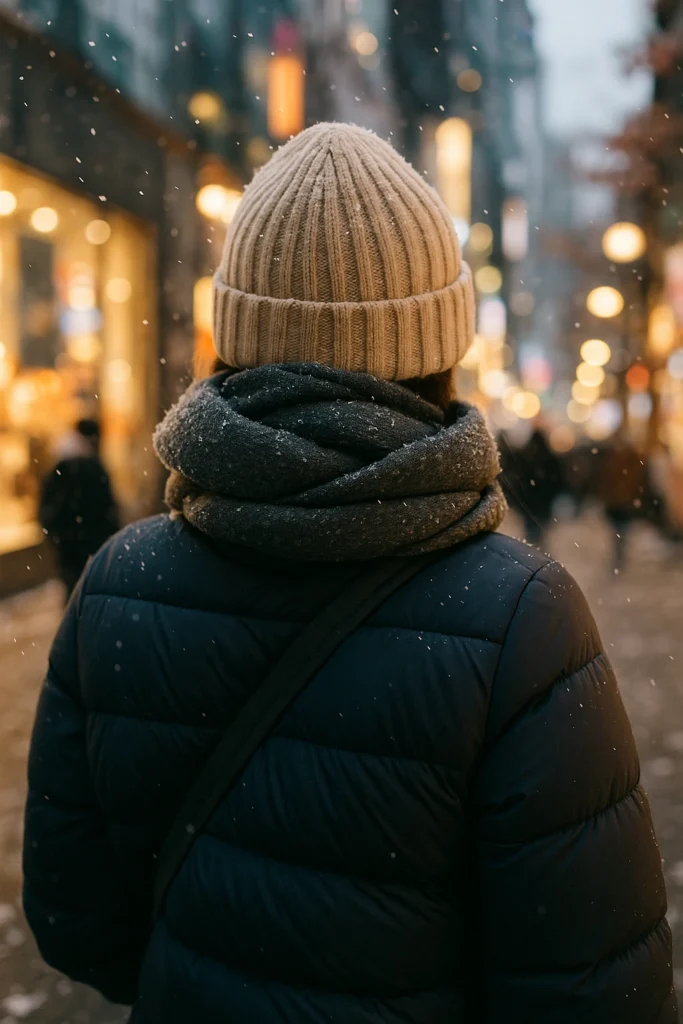I remember my first Korean winter. I thought my thickest jacket from back home would be enough. Boy, was I wrong! The cold here, especially the bone-chilling wind, is on a whole different level. It’s not just about the temperature; it’s about the feeling of the wind slicing right through your clothes. If you’re planning a trip, let me save you from the painful mistake of underpacking. This guide is based on real-life experience and will help you pack smart and stay genuinely warm! 😊

The Korean Winter Reality Check: It’s Colder Than You Think! 🥶
The average temperature in Seoul during January often hovers around -6°C (21°F), but that number is misleading. Because of the Siberian high pressure system, Korea experiences what locals call a “Three Cold, Four Warm” cycle, but the cold days are *intensely* cold. Your packing strategy must account for this.
Temperature vs. Wind Chill: The Sneaky Killer
Trust me, the biggest challenge isn’t the thermometer reading—it’s the wind chill factor. The wind in places like Seoul and especially the coast can make -5°C feel like -15°C. This is why a simple thick sweater won’t cut it. You need a system.
On surprisingly warm winter days, the air quality (fine dust) can be a problem. Always pack a few N95 or KF94 masks. They help keep you warm *and* protect your lungs!
The 3-Layer System: Pack Like an Expert Climber 🧳
As a long-term resident, I swear by the three-layer method. It’s the most effective way to manage the intense cold outside and the aggressively warm indoor heating (Ondol) you’ll encounter everywhere in Korea.
- Base Layer: The Foundation: This is the most critical layer. You need thermal underwear (known as “내복” (Naebok) in Korea) that wicks moisture. Forget cotton; go for merino wool or modern synthetic thermals.
- Mid-Layer: Insulation: Think fleece, down vests, or wool sweaters. This layer traps heat. Make sure it’s something you can easily take off and put back on when going in and out of buildings.
- Outer Layer: Wind and Water Barrier: A high-quality, long padded jacket (like the “long-paddings” popular in Korea) is non-negotiable. It must be windproof and preferably waterproof/resistant. Hoods are a huge plus!
If your outer coat is the only thing keeping you warm, you will overheat and sweat indoors, and then get dangerously cold when you step back outside. Layering is key to adapting.
The Real Game Changers: Accessories You Must Pack 🧤
Your extremities will suffer the most. Seriously, these are the items I often see unprepared tourists struggling without. Do not skip these!
Footwear and Socks: Keep Your Toes Toasty
| Item | Why You Need It (E-E-A-T) |
|---|---|
| Waterproof Winter Boots | Seoul sees snow and ice. You need good grip and insulation. Simple fashion sneakers are a recipe for slipping and cold feet. |
| Merino Wool Socks (4-5 pairs) | The single best investment. They retain heat even if they get slightly damp, unlike cotton. Pack more than you think you need. |
| Winter Insoles (Optional but recommended) | Add an extra layer of thermal protection from the ground up, essential for long outdoor days, like visiting a temple or palace. |
The Head and Hand Must-Haves
- Scarf or Neck Gaiter: The wind enters through the neck. A high-quality wool or fleece scarf is vital for sealing the gap.
- Thermal Gloves or Mittens: Bring a pair that allows you to use your phone (touchscreen compatible), as you’ll be navigating frequently. Mittens are generally warmer.
- Beanie or Earmuffs: Protecting your head is crucial for retaining body heat. A simple beanie is a stylish and effective barrier.
The Korean Secret Weapon: Hot Packs (핫팩) 📝
Don’t bother packing these—they are dirt cheap and ubiquitous in Korea (convenience stores, Daiso, subway stations). I always buy a handful of “붙이는 핫팩” (stick-on hot packs) for my base layer and put a regular one in my pockets for my hands. Absolute lifesavers for winter festivals or hiking.
- Hand Warmer Hot Packs: For pockets or gloves.
- Body Hot Packs: Stick them on your stomach or back (over your base layer, not directly on skin!).
Your Korea Winter Packing Action Plan 📝
To summarize, your bag should prioritize function over sheer bulk. Focus on these three core categories for a comfortable trip:
- Layering: Base thermals (x5) + Mid-layers (x3) + One premium, windproof outer layer.
- Extremity Protection: Wool socks, waterproof boots, thermal gloves, and a neck covering.
- Local Buys: Plan to purchase KF94 masks and Hot Packs once you arrive.
Frequently Asked Questions About Korean Winter Packing ❓
Packing for a Korean winter can feel intimidating, but with the right preparation—and the key concept of strategic layering—you’ll be ready to enjoy all the magic this country offers, from dazzling Christmas lights to hot street food. Don’t forget to grab a warm beverage! If you have any more specific questions about my favorite Korean winter gear, feel free to drop them in the comments below! 😊
